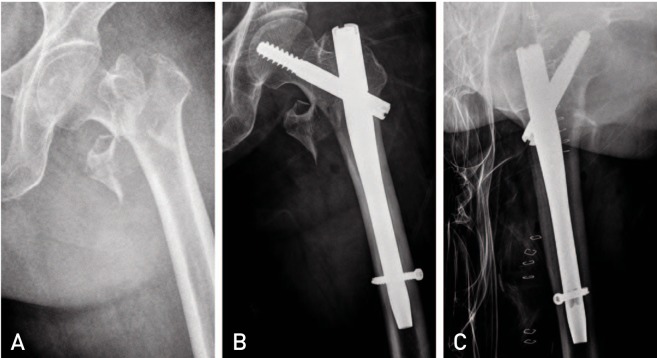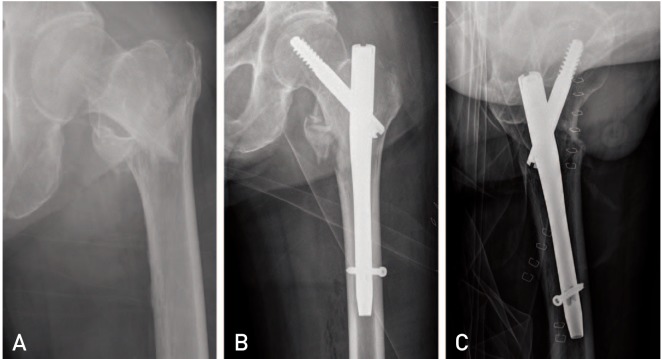Hip Pelvis.
2016 Dec;28(4):225-231. 10.5371/hp.2016.28.4.225.
Surgical Results of the Cephalomedullary Nail for the Femoral Intertrochanteric Fracture: Comparison between Non-experienced Surgeons and Experienced Surgeon
- Affiliations
-
- 1Department of Orthopedic Surgery, Seoul Medical Center, Seoul, Korea. heavystone75@gmail.com
- KMID: 2364700
- DOI: http://doi.org/10.5371/hp.2016.28.4.225
Abstract
- PURPOSE
Cephalomedullary nail (CM nail) in the treatment of femoral intertrochanteric fractures is in the lime light in recent years. The purpose of this study is to compare surgical outcomes between experienced surgeon and non-experienced surgeons in respect of CM nail for femoral intertrochanteric fractures.
MATERIALS AND METHODS
The 129 patients underwent CM nail for femoral intertrochanteric fracture more than six months of follow-up from April 2011 to March 2014 in Seoul Medical Center (Seoul, Korea) were participated in this study. For this study, group A consisted of experienced surgeons who performed more than 500 times of CM nail, and group B consisted of non-experienced surgeons who performed less than 50 times of CM nail. Clinical and radiologic outcomes, complications and the need for reoperation between both groups were compared in the study.
RESULTS
According to clinical result, both the mean operation time and transfusion volume were significantly longer and greater in group B (P<0.05). In the radiologic outcomes, adequacy of reduction, tip-apex distance and numbers of case placed in the Cleveland zones 5, 6 and 8; there was no statistical difference between both groups. Moreover, rate of complication and reoperation had same results as radiologic outcomes.
CONCLUSION
There was no significant difference with statistical data in complications from CM nail for femoral intertrochanteric fractures between experienced surgeon and non-experienced surgeon. Although the operation time and transfusion volume were significantly longer and greater in the case of operation by non-experienced surgeon, satisfactory performance was seen in the complications and the need for reoperation.
Figure
Reference
-
1. Hernández JL, Olmos JM, Alonso MA, et al. Trend in hip fracture epidemiology over a 14-year period in a Spanish population. Osteoporos Int. 2006; 17:464–470. PMID: 16283063.
Article2. Lönnroos E, Kautiainen H, Karppi P, et al. Increased incidence of hip fractures. A population based-study in Finland. Bone. 2006; 39:623–627. PMID: 16603427.
Article3. Richmond J, Aharonoff GB, Zuckerman JD, Koval KJ. Mortality risk after hip fracture. J Orthop Trauma. 2003; 17:S2–S5. PMID: 14696770.
Article4. Siegmeth AW, Gurusamy K, Parker MJ. Delay to surgery prolongs hospital stay in patients with fractures of the proximal femur. J Bone Joint Surg Br. 2005; 87:1123–1126. PMID: 16049251.
Article5. Kaplan K, Miyamoto R, Levine BR, Egol KA, Zuckerman JD. Surgical management of hip fractures: an evidence-based review of the literature. II: intertrochanteric fractures. J Am Acad Orthop Surg. 2008; 16:665–673. PMID: 18978289.
Article6. Sadowski C, Lübbeke A, Saudan M, Riand N, Stern R, Hoffmeyer P. Treatment of reverse oblique and transverse intertrochanteric fractures with use of an intramedullary nail or a 95 degrees screw-plate: a prospective, randomized study. J Bone Joint Surg Am. 2002; 84-A:372–381. PMID: 11886906.7. Sung YB, Nam CH, Ahn JK, Sohn YJ, Chung HJ, Kim JH. A comparative study between the proximal femoral nail and dynamic hip screw for intertrochanteric fracture -preliminary report. J Korean Hip Soc. 2002; 14:208–215. Korean.8. Nuber S, Schönweiss T, Rüter A. Stabilisation of unstable trochanteric femoral fractures. Dynamic hip screw (DHS) with trochanteric stabilisation plate vs. proximal femur nail (PFN). Unfallchirurg. 2003; 106:39–47. German. PMID: 12552392.9. Yuan X, Yao Q, Ni J, Peng L, Yu D. Proximal femoral nail antirotation versus dynamic hip screw for intertrochanteric fracture in elders: a meta-analysis. Zhonghua Yi Xue Za Zhi. 2014; 94:836–839. Chinese. PMID: 24854751.10. Kwon CS, Kim BJ, Go HS, Kim YU, Kim ES. Gamma nailing in pertrochanteric fracture of femur. J Korean Hip Soc. 1991; 3:87–93.11. Kaufer H. Mechanics of the treatment of hip injuries. Clin Orthop Relat Res. 1980; (146):53–61. PMID: 7371269.
Article12. Dorr LD, Faugere MC, Mackel AM, Gruen TA, Bognar B, Malluche HH. Structural and cellular assessment of bone quality of proximal femur. Bone. 1993; 14:231–242. PMID: 8363862.
Article13. Saudan M, Lübbeke A, Sadowski C, Riand N, Stern R, Hoffmeyer P. Pertrochanteric fractures: is there an advantage to an intramedullary nail?: a randomized, prospective study of 206 patients comparing the dynamic hip screw and proximal femoral nail. J Orthop Trauma. 2002; 16:386–393. PMID: 12142826.14. Keats AS. The ASA classification of physical status--a recapitulation. Anesthesiology. 1978; 49:233–236. PMID: 697075.
Article15. Baumgaertner MR, Solberg BD. Awareness of tip-apex distance reduces failure of fixation of trochanteric fractures of the hip. J Bone Joint Surg Br. 1997; 79:969–971. PMID: 9393914.
Article16. Cleveland M, Bosworth DM, Thompson FR, Wilson HJ Jr, Ishizuka T. A ten-year analysis of intertrochanteric fractures of the femur. J Bone Joint Surg Am. 1959; 41-A:1399–1408. PMID: 13849408.
Article17. Baumgaertner MR, Curtin SL, Lindskog DM. Intramedullary versus extramedullary fixation for the treatment of intertrochanteric hip fractures. Clin Orthop Relat Res. 1998; (348):87–94. PMID: 9553538.
Article18. Wang W, Yang T, Fang Y, Wang G, Pu J, Liu L. [Treatment of reverse oblique fractures of intertrochanteric region of femur with proximal femoral nail antirotation]. Zhongguo Xiu Fu Chong Jian Wai Ke Za Zhi. 2009; 23:1306–1310. Chinese. PMID: 19968168.19. Zeng C, Wang YR, Wei J, et al. Treatment of trochanteric fractures with proximal femoral nail antirotation or dynamic hip screw systems: a meta-analysis. J Int Med Res. 2012; 40:839–851. PMID: 22906256.
Article20. He YQ, Ruan ZY, Xiang C, Zhang G, Zhu QW, Qian Z. Treatment of intertrochanteric fractures over age of 80 years old patients with proximal femur intramedullary nail. Zhongguo Gu Shang. 2013; 26:833–835. Chinese. PMID: 24490531.21. Altintas B, Biber R, Bail HJ. The learning curve of proximal femoral nailing. Acta Orthop Traumatol Turc. 2014; 48:396–400. PMID: 25230261.
Article22. Gundle R, Gargan MF, Simpson AH. How to minimize failures of fixation of unstable intertrochanteric fractures. Injury. 1995; 26:611–614. PMID: 8550168.
Article23. Sommers MB, Roth C, Hall H, et al. A laboratory model to evaluate cutout resistance of implants for pertrochanteric fracture fixation. J Orthop Trauma. 2004; 18:361–368. PMID: 15213501.
Article24. Kim WY. Treatment for the acetabular fracture. J Korean Hip Soc. 2010; 22:116–121.
Article25. Herrera A, Domingo LJ, Calvo A, Martínez A, Cuenca J. A comparative study of trochanteric fractures treated with the Gamma nail or the proximal femoral nail. Int Orthop. 2002; 26:365–369. PMID: 12466870.
- Full Text Links
- Actions
-
Cited
- CITED
-
- Close
- Share
- Similar articles
-
- New Approach in the Treatment of Intertrochanteric Fracture Using a Cephalomedullary Nail
- Comparative Study of Intertrochanteric Fracture Treated with the Proximal Femoral Nail Anti-Rotation and the Third Generation of Gamma Nail
- Treatment of Femoral Intertrochanteric Fracture with Proximal Femoral Nail
- Injury of the Superficial Femoral Artery Secondary to an Unstable Intertrochanteric Fracture: A Case Report
- Internal Fixation of Pauwels Type-3 Undisplacedincomplete Insufficiency Femoral Neck Fractures with Cephalomedullary Nails



